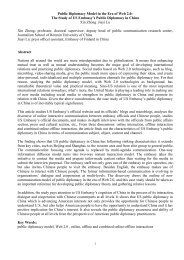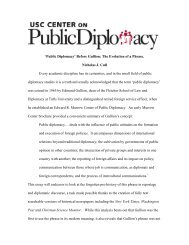Buddhist Diplomacy: History And Status Quo. - USC Center on ...
Buddhist Diplomacy: History And Status Quo. - USC Center on ...
Buddhist Diplomacy: History And Status Quo. - USC Center on ...
- No tags were found...
Create successful ePaper yourself
Turn your PDF publications into a flip-book with our unique Google optimized e-Paper software.
BUDDHIST DIPLOMACY: HISTORY AND STATUS QUO 11Burma until the 5th century CE. Early Buddhism in Burma wasMahayana Buddhism rather than Theravada. Around 1075 CE, KingAnawrahta Minsaw, the founder of the Pagan dynasty, requested forthe Tripitaka from the king of That<strong>on</strong>, but he was turned down. Theenraged king attacked and c<strong>on</strong>quered That<strong>on</strong> and brought <str<strong>on</strong>g>Buddhist</str<strong>on</strong>g>scriptures and Theravada <str<strong>on</strong>g>Buddhist</str<strong>on</strong>g> clergy back to Burma. HenceBurma became a center for the orthodox Theravada Buddhism,which became the dominant state religi<strong>on</strong> and played significant rolein its social and political life. 30The earliest known kingdom in today’s Cambodia was calledFunan, which appeared roughly in the 1st century CE. The kingdomwas subject to both Indian Brahmanical and <str<strong>on</strong>g>Buddhist</str<strong>on</strong>g> influence in itsearly years. But Buddhism appeared to have become the dominantreligi<strong>on</strong> as late as the 5th century, and the kingdom had become ahub for religious exchanges between China and India. Some eminent<str<strong>on</strong>g>Buddhist</str<strong>on</strong>g> m<strong>on</strong>ks were sent al<strong>on</strong>g with embassies by Funan’s kings toChina. The successive Zhenla dynasty (550–802 CE) appears to havepracticed both Hinduism and Mahayana Buddhism, and Buddhismstarted to spread from the court to the mass. The Mahayana influencewas likely a result of the Nalanda M<strong>on</strong>astery-University complexduring the Indian Pala Empire. 31 In the early Angkor period (802–1432CE), Mahayana Buddhism gradually became the dominant faithin the kingdom as a result of royal sp<strong>on</strong>sorship. King JayavarmanVII (1181-1219 CE) was extremely devoted to Buddhism. From the13th century <strong>on</strong>, Theravada Buddhism had become the dominantreligi<strong>on</strong> in Angkor, probably due to the influence from Thailand’sTheravada <str<strong>on</strong>g>Buddhist</str<strong>on</strong>g> reformati<strong>on</strong>.3. Transmissi<strong>on</strong> of Buddhism to Central Asia and East Asia—Mahayana Buddhisma. Spread of Buddhism to Central Asia.Buddhism started to spread to Northwestern India during theBuddha’s lifetime (see SA.35.88). The government officials incharge of Dharma affairs during Emperor Asoka’s reign workedam<strong>on</strong>g “the Gandharas”, “Y<strong>on</strong>as” and “Kambojas”, which lay in











